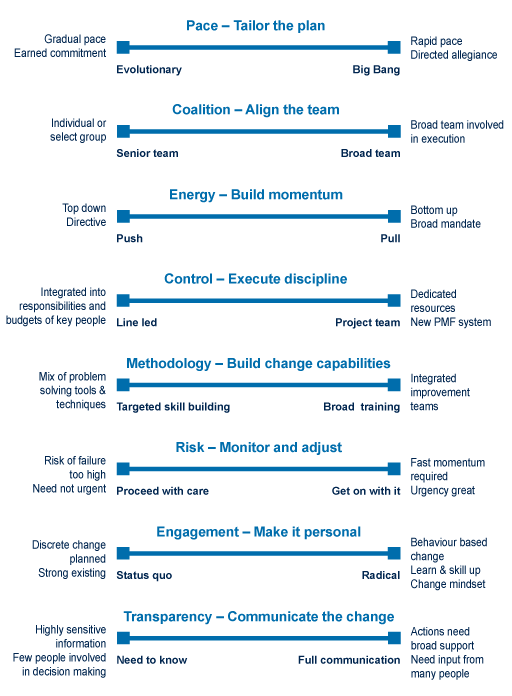5.2 Strategic analysis
In order for change to be successful, you need to analyse the risk, resistance and tactics for change and how ready your organisation is for change. By doing a strategic change analysis, it will help you understand what attitudes and behaviours you may have to manage.
- Risk assessment – the risk of not managing the people side of change on a particular change is related to the dimensions described in the 'Situation assessment' section. Changes that are more ‘dramatic’ and further reaching in the organisation have a higher change management risk. Likewise, organisations and groups with histories and cultures that resist change face higher change management risk. In developing the strategy, overall risk and specific risk factors are documented.
- Anticipated resistance – many times, after a project is introduced and meets resistance, members of the team reflect that ‘they saw that reaction coming.’ In creating the change management strategy, you can identify where resistance can be expected. Are regions or divisions impacted differently than others? Were certain groups advocating a different solution to the same problem? Are some groups heavily invested in how things are done today?
- Special tactics – the final step of the change management strategy is the identification of any special tactics that will be required for this change initiative. The special tactics formalise much of the learning from the strategy development related to the change and how it impacts different audiences in the organisation. Throughout the change implementation, special tactics may need to be revisited and updated.
- Readiness assessment – assessing the organisation’s ‘readiness for change’ is a key aspect of strategic analysis. It provides a benchmark of where the organisation is prior to the instigation of the change initiative. Regular revisits to the assessment throughout the lifecycle of the change will provide an indication of the progress made, as well as what adjustments to attitudes and behaviours have yet to happen.
Depending on the size of the change initiative, a change readiness assessment can be conducted using a simple form (like the one shown in Table 4 below) or a more complex tool or platform.
| Questions: | How fast do you want to implement the change? What are the timescales, and have you worked backwards to see if it is possible? Is the change project integrated with other strategies? Is it agreed – evolution or revolution? Do you have the leadership capabilities to match? |
| What are you doing well? | |
| What do you need to do? | |
| Coalition - Align the team | |
| Questions: | How broad does your top team need to be? Are 70% of the executive committed to the change? How will the stakeholders be engaged? Do you have a political champion? Are the vision and drivers clear and shared? Are the roles and responsibilities of the top team clear and understood? Have the right behaviours as role models been defined? How do you plan to keep the top team engaged? |
| What are you doing well? | |
| What do you need to do? | |
| Energy - Build momentum | |
| Questions: | How can you create and sustain the energy? Has the resource been identified and agreed? Has a programme office been established? Has backfill been agreed is necessary? Has the resource been freed up? |
| What are you doing well? | |
| What do you need to do? | |
| Control - Execute discipline | |
| Questions: | How much central control is required? Is ‘Go see’ established? Are roles and responsibilities defined and understood? Have champions been briefed and prepared? Have milestones been set and governance put in place? Are links made to service/business plans? |
| What are you doing well? | |
| What do you need to do? | |
| Methodology - Build change capabilities | |
| Questions: | How do you overcome your unique challenges? Have you selected a suitable organisation approach? Have champions/change agents been identified? Has a core team been selected? Have all key skills been identified, for example, BPI, procurement, marketing, contract management, others? Has a skills assessment been completed? Are training needs linked to the organisational development plan? |
| What are you doing well? | |
| What do you need to do? | |
| Risk - Monitor and adjust | |
| Questions: | How do you handle the risk of the planned changes? Is your attitude to risk appropriate for the pace you want? Is governance in place? Is it working? Have you established the correct measures? Do you have good performance information? |
| What are you doing well? | |
| What do you need to do? | |
| Engagement - Make it personal | |
| Questions: | How differently must people behave? Have you defined the new culture? Are the role models leading the change? Are people clear (WIIFM – what's in it for me)? Have the links been made with organisational development to the performance development reviews? Are the objectives linked to the day job? |
| What are you doing well? | |
| What do you need to do? | |
| Transparency - Communicate the change | |
| Questions: | How much transparency do you need? Do you want to brand the programme? |
| What are you doing well? | |
| What do you need to do? | |
Figure 11 provides more information about each of the steps outlined in Table 4.
Activity 7 How ready for change are you?
Think about your organisation’s readiness for change. Using the readiness assessment form in Table 4, and the additional information in Figure 11, what could you personally do in each step to become an effective change agent?
Having identified your supporting structure and carried out a strategic analysis, it is a good idea to bear in mind what is involved in leading change. This is the topic of the next section.

